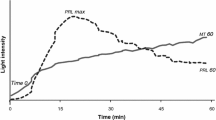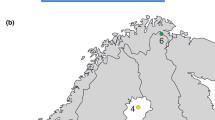Summary
Light-refracting bodies, possibly photoreceptors, occurring in the posterior lobes of the brain are considered characteristic for most species of catenulid turbellarians of the freshwater genus Stenostomum. In S. virginianum, each of two light-refracting bodies consists of a single cup-shaped granule (3–4 μm) situated in the perikaryon of a single nerve cell (the ‘clear vesicle’ of earlier papers). TEM reveals each granule as an enlarged and folded mitochondrion with a dense matrix inclusion of undetermined composition. Cristae are well-developed and there is a dense granular extramito-chondrial layer of uniform thickness (100 nm) along the posteromedial surface of the mitochondrion. The perikaryon is packed with ribosomes, β-glycogen granules and 60–100 nm dense-cored vesicles. A neurite extends from the perikaryon into the neuropile of the brain. Experimental data indicate an absence of phototaxis and photokinesis and an absence of ultrastructural modifications with light- and dark-adaptation. An ultrastructural comparison is made of the light-refracting bodies of S. virginianum with those of a second species. Hypotheses regarding the role of light-refracting bodies as photoperiodic receptors and/or specialized neurosecretory cells are advanced.
Similar content being viewed by others
References
Bedini C, Ferrero E, Lanfranchi A (1977) Fine structural changes induced by circadian light-dark cycles in photoreceptors of Dalyellidae (Turbellaria: Rhabdocoela). J Ultrastruct Res 58:66–77
Borkott H (1970) Geschlechtliche Organisation, Fortpflanzungsverhalten und Ursachen der sexuellen Vermehrung von Stenostomum sthenum nov. spec. (Turbellaria, Catenulida). Z Morphol Tiere 67:183–262
Carpenter KS, Morita M, Best JB (1974) Ultrastructure of the photoreceptor of the planarian Dugesia dorotocephala. II. Changes induced by darkness and light. Cytobiologie 8:320–338
Doe D, Rieger RM (1977) A new species of the genus Retronectes (Turbellaria, Catenulida) from the coast of North Carolina, USA. Mikrofauna Meeresboden 66:549–556
Eakin RM (1968) Evolution of Photoreceptors. In: Dobzhansky T, Hecht MK, Steere WC (eds) Evolutionary Biology Vol 2, Appleton-Century-Crofts, New York pp 194–242
Eakin RM, Brandenburger JL (1979) Effects of light on ocelli of seastars. Zoomorphologie 92:191–200
Ehlers B, Ehlers U (1977) Ultrastruktur pericerebraler Cilienaggregate bei Dicoelandropora atriopapillata Ax and Notocaryoplanella glandulosa Ax (Turbellaria, Proseriata). Zoomorphologie 88:163–174
Faubel A (1976) Eine neue Art der Gattung Retronectes (Turbellaria, Catenulida) aus dem Küstengrundwasser der Nordseeinsel Sylt. Zool Scripta 5:217–220
Hagadorn IR (1962) Neurosecretory phenomena in the leech Theromyzon rude. In: Heller H, Clark RB (eds) Proc. III Int. Symp. Neurosecretion. Mem Soc Endocrin 12:313–325
Hyman LH (1951) The invertebrates: Platyhelminthes and Rhyncocoela. The Acoelomate Bilateria. Vol 2. McGraw Hill, New York. p 97
Kaplońska J (1967) Neurosecretion in Tricladida with the reference to seasonal variations and changes occuring in the course of regeneration. Zool Poloniae 17:73–96
Karling TG (1974) On the anatomy and affinities of the turbellarian orders. In: Riser NW, Morse MP (eds) Biology of the Turbellaria. McGraw Hill, New York. pp 1–16
Lender T (1974) The role of neurosecretion in freshwater planarians. In: Riser NW, Morse MP (eds) Biology of the Turbellaria. McGraw Hill, New York. pp 460–475
MacRae EK (1964) Observations on the fine structure of photoreceptor cells in the planarian Dugesia tigrina. J Ultrastruct Res 10:334–349
MacRae EK (1966) Fine structure of the photoreceptors in a marine flatworm. Z Zellforsch Mikrosk Anat 75:469–484
Moraczewski J Czubaj A, Kwiatkowska J (1977) Localization of neurosecretion in the nervous system of Catenulida (Turbellaria). Zoomorphologie 87:97–102
Nuttycombe JW, Waters AJ (1938) The American species of the genus Stenostomum. Proc Am Phil Soc 79:213–301
Palade GE (1959) Functional changes in the structure cell components. In: Hayashi T (ed) Subcellular Particles. Ronald Press, New York. pp 64–83
Pennak RW (1978) Fresh-Water Invertebrates of the United States. John Wiley and Sons, New York. p 803
Rieger RM (1978) Multiple ciliary structures in developing spermatozoa of marine Catenulida (Turbellaria). Zoomorphologie 89:229–236
Röhlich P (1968) Fine structural changes induced in photoreceptors by light and prolonged darkness. In: Salanki J (ed) Neurobiology of Invertebrates. Plenum Press, New York. pp 95–105
Ruppert EE (1978) A review of metamorphosis of turbellarian larvae. In: Chia FS, Rice ME (eds) Settlement and Metamorphosis of Marine Invertebrate Larvae. Elsevier, New York. pp 65–81
Sonneborn TM (1930) Genetic studies on Stenostomum incaudatum (nov. sp.). I. The nature and origin of differences among individuals formed during vegetative reproduction. J Exp Zool 57:57–74
Sterrer W, Rieger RM (1974) Retronectidae — a new cosmopolitan marine family of Catenulida (Turbellaria). In: Riser NW, Morse MP (eds) Biology of the Turbellaria. McGraw Hill, New York. pp 63–92
Yamamoto M, Yoshida M (1978) Fine structure of the ocelli of a synaptid holothurian, Opheodesoma spectabilis, and effects of light and darkness. Zoomorphologie 90:1–17
Author information
Authors and Affiliations
Additional information
This study was supported in part by a National Science Foundation grant DEB-7823395 and a Clemson University Faculty Research Grant to E. Ruppert
Rights and permissions
About this article
Cite this article
Ruppert, E.E., Schreiner, S.P. Ultrastructure and potential significance of cerebral light-refracting bodies of Stenostomum virginianum (Turbellaria, Catenulida). Zoomorphology 96, 21–31 (1980). https://doi.org/10.1007/BF00310074
Received:
Issue Date:
DOI: https://doi.org/10.1007/BF00310074




